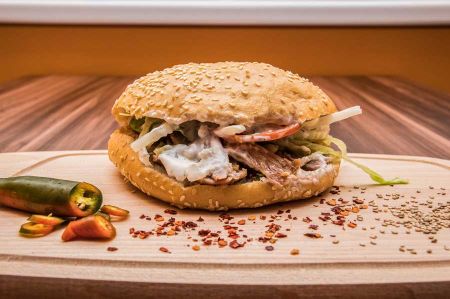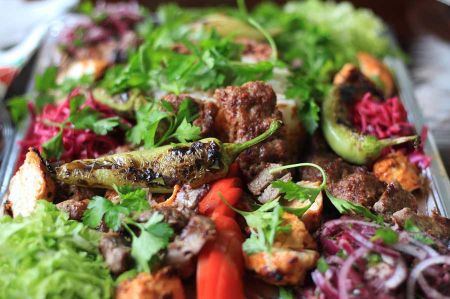Culinary regional allocation of specialties in Turkey
- Written by Portal Editor
Traveling through Turkey always means dealing with the local products and specialties, be it in the Andana region, where you should of course rely on the Adana kebab as a local specialty for the main course, as well as the Urfa kebab, if to travel to the Sanliurfa region.
Of course, I can also have both dishes served in Izmir, without any question and they are definitely delicious there, especially since the restaurant operator can also have his origins in Adana or Sanliurfa. The assignment of specialties to a region is always interesting, especially since discussions and disputes about the origin of certain specialties occur again and again.
The Döner kebab - Turkish, Arabic or even from Berlin?
 The best example of this: the kebab. A typical Turkish dish? Or rather Arabic? Some Berliners also claim to be "inventors" or at least further developers and defend themselves with hands and feet.
The best example of this: the kebab. A typical Turkish dish? Or rather Arabic? Some Berliners also claim to be "inventors" or at least further developers and defend themselves with hands and feet.
When the first kebab shop opened in Germany is still unclear. Legend has it that it was on Kottbusser Damm in Berlin in the early 1970s. According to another account, which is confirmed by the Association of Turkish Döner Manufacturers, the kebab - back then as grilled meat in flatbread only with onions - including its preparation on a rotating metal skewer is said to have been invented by the Turkish immigrant Kadir Nurman and never patented; his first kebab shop was at the Zoo train station in the early 1970s. Nevzat Salim claims to have offered the doner kebab in Reutlingen as early as 1969.
Origin information on the origin of many specialty establishments
 In order to at least counteract these disputes, there should be a map in the future that shows the origin information of specialties as a geographical representation and card index. For all seven regions and thus for 81 provinces of Turkey such a map and a parallel file of the geographical certificates of origin were produced. The initiator of this action was the Antalya Trade Exchange (ATB), through which, for the first time, hundreds of years old Anatolian, local products were registered and entered in a card index. The background here is the transfer of knowledge to future generations, as well as opening up to international markets in trade and export.
In order to at least counteract these disputes, there should be a map in the future that shows the origin information of specialties as a geographical representation and card index. For all seven regions and thus for 81 provinces of Turkey such a map and a parallel file of the geographical certificates of origin were produced. The initiator of this action was the Antalya Trade Exchange (ATB), through which, for the first time, hundreds of years old Anatolian, local products were registered and entered in a card index. The background here is the transfer of knowledge to future generations, as well as opening up to international markets in trade and export.
The number of geographically identified products, which 10 years ago was only 109 specialties, has now risen to 633 specialties. In Europe, 5 products received certificates of origin and thus geographical trademark protection. According to the social media accounts of ATB President Ali Candir, the Black Sea region has 143 regional products, the maximum number of products with registered geographical certificates of origin. With 37 registrations, Gaziantep is Turkey's first province in this regard. 9 products are Turkey-wide registered as a common good. Some examples of these products are the traditional Turkish raspberry, strawberry, rose, apricot and cherry liqueurs, the Turkish raki (aniseed schnapps) and also the Turkish hound.
Some examples of these products are the traditional Turkish raspberry, strawberry, rose, apricot and cherry liqueurs, the Turkish raki (aniseed schnapps) and also the Turkish hound.
Çandır stated that the number of Turkish products with a geographical certificate of origin valid throughout the EU is currently 5 specialties. 16 products are currently in the application phase to the European Commission. "Gaziantep Baklava, Aydın Feige, Aydın Chestnut, Malatya Apricot and most recently Milas Olive Oil have been registered with the EU. Our work continues in this direction." Registering geographical origins is not the end of the first goal, but the beginning of a business.
Adana kebab with flatbread, grilled tomatoes and parsley
 Adana Kebap is a meat dish and a specialty of Turkish cuisine from the Turkish province of Adana. It mainly consists of minced meat grilled on skewers over charcoal and is a spicy variant of the Köfte. It is served with grilled tomatoes and peppers, flatbread, parsley, lemon, radish, lettuce and red onions seasoned with sumac; Rice and cacık are rarely served with it.
Adana Kebap is a meat dish and a specialty of Turkish cuisine from the Turkish province of Adana. It mainly consists of minced meat grilled on skewers over charcoal and is a spicy variant of the Köfte. It is served with grilled tomatoes and peppers, flatbread, parsley, lemon, radish, lettuce and red onions seasoned with sumac; Rice and cacık are rarely served with it.
Traditionally, the minced meat in Adana is made by hand using large knives from fatty mutton or lamb. It is seasoned with salt and chilli flakes, which are called Pul Biber in Turkish and which ensure the heat. Traditionally, the Adana Kebab is not additionally seasoned with onions, garlic and parsley. The finished mass is divided into portions, which are kneaded around a flat metal skewer for grilling.
Classic for breakfast - Menemen
 Menemen is not just a Turkish egg dish that is usually eaten for breakfast or on summer days, no, there is also a town of this name near Izmir. Can you see the origin of the breakfast specialty here? Menemen usually contain eggs, tomatoes, green peppers, hot peppers, and onions, as well as spices such as salt, pul beaver, black and red pepper, and paprika powder. Menemen are usually prepared in small pans in which the dish is also served.
Menemen is not just a Turkish egg dish that is usually eaten for breakfast or on summer days, no, there is also a town of this name near Izmir. Can you see the origin of the breakfast specialty here? Menemen usually contain eggs, tomatoes, green peppers, hot peppers, and onions, as well as spices such as salt, pul beaver, black and red pepper, and paprika powder. Menemen are usually prepared in small pans in which the dish is also served.
The preparation of menemes is very variable and roughly corresponds to that of other egg dishes such as the German farmer's breakfast, scrambled eggs with vegetables or an omelette.
The onions are heated in melted butter or olive oil, then the peppers, hot peppers and chopped tomatoes are added. As soon as the tomatoes are soft, add one or two eggs per serving. The eggs are stirred and should be whipped completely, but must not dry out.
Common additions are cheese, especially the feta-like white cheese (beyaz peynir), and sausage, such as the Turkish garlic sausage sucuk. White bread is usually served with menemen.
Tahini side dish and dip with numerous dishes
Tahini is a paste made from finely ground sesame seeds. It comes from Arabic cuisine and is a basic ingredient in hummus (chickpea sauce). It is also served as a side dish or as a dip, mixed with lemon juice and garlic and often seasoned with sumac.
A distinction is made between peeled and unpeeled sesame tahini. Tahini made from unpeeled sesame seeds is darker, but contains more vitamins, nutrients and, at around 10 grams per 100 grams, more fiber. Often, tahini is made from a mixture of both sesame seeds. Tahina made exclusively from peeled sesame is called white tahini.
Please read as well:
Lake Garda - a popular holiday destination in outdoor tourism
Ohrid Lake - The place of the Living Fossils
